Key takeaways:
- Cooking recipes blend art and science, allowing personal creativity while providing structure.
- Key to a flaky pie crust includes using cold fat, proper mixing techniques, and allowing dough to rest.
- Ingredient choice significantly affects the outcome; for example, using pastry flour improves crust tenderness.
- Consistent techniques, such as chilling dough and properly measuring ingredients, lead to reliable baking results.
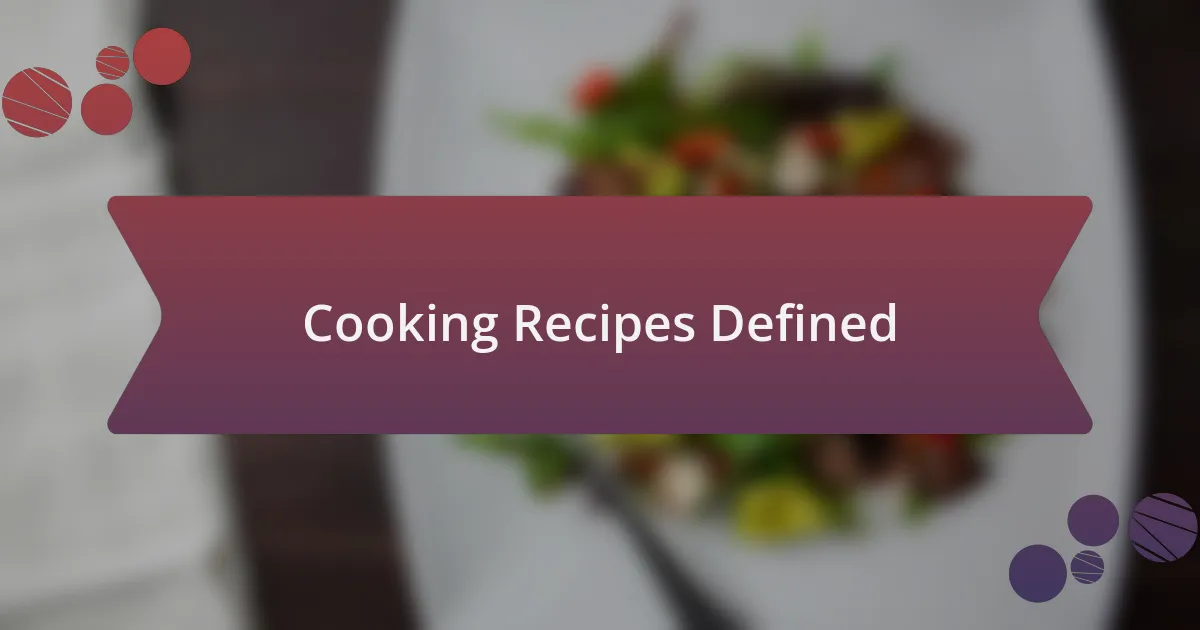
Cooking Recipes Defined
Cooking recipes are more than just a list of ingredients and steps; they are a harmonious blend of art and science. I remember the first time I tried to create a pie crust from scratch. It felt intimidating, yet there was something incredibly liberating about transforming simple flour, butter, and water into a flaky masterpiece.
At their core, recipes serve as a guide, allowing home cooks to nurture their creativity while ensuring that the final dish is both delicious and visually appealing. Have you ever followed a recipe only to feel the urge to tweak it? That’s the beauty of cooking; while a recipe provides structure, it also invites us to infuse our personal touch and preferences into each dish.
When I realized that a recipe isn’t just a set of instructions but a story waiting to be told, my cooking journey blossomed. Each recipe reflects not only the ingredients but also the emotions and memories attached to it, making the act of cooking a deeply personal experience. Isn’t it fascinating how a simple pie crust can evoke feelings of nostalgia and comfort?
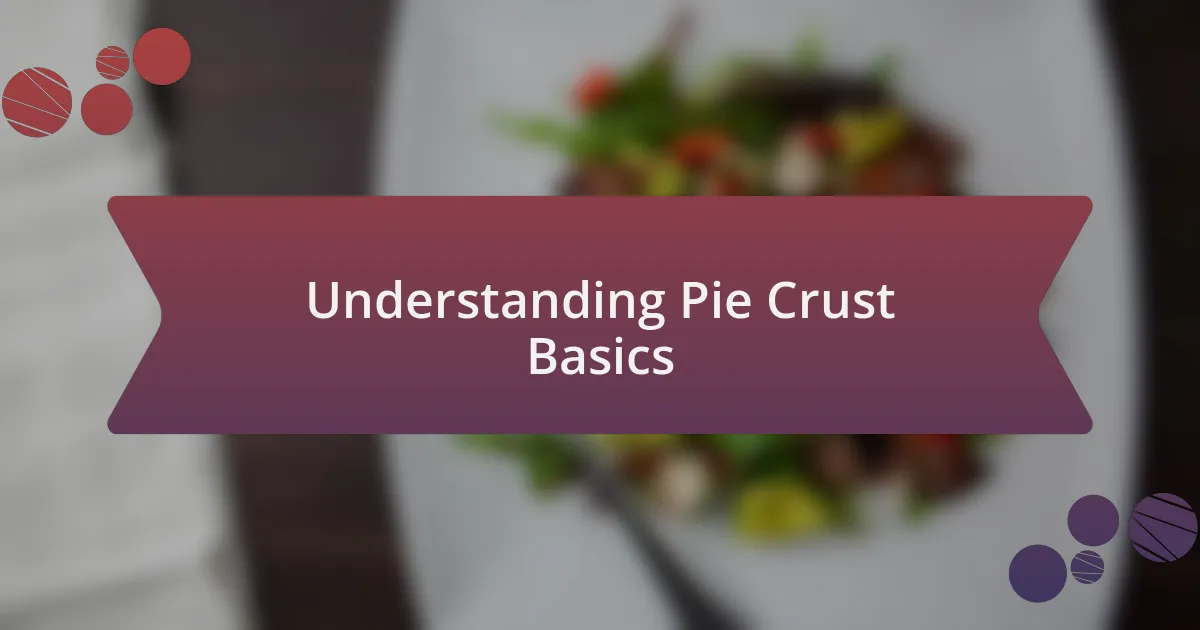
Understanding Pie Crust Basics
When I first started making pie crusts, I learned that the three main ingredients—flour, fat, and water—each play a crucial role. Flour provides structure, while fat, typically butter or shortening, creates that tantalizing flakiness we all crave. I remember the first pie crust I made using cold butter; the texture was so much better compared to when I used room temperature butter. It was a revelation.
The technique you employ to mix these ingredients is just as important as the ingredients themselves. I used to think that mixing them until smooth was the way to go, but I soon realized that leaving some small pieces of fat intact is key to achieving that desired flakiness. Have you ever tried a crust that was too tough? It can be disappointing. Now, I mix just until combined, ensuring the fat goes in cold and then I chill the dough before rolling it out.
Finally, the resting period is often overlooked but is critical for success. I felt the difference when I started letting my dough rest in the fridge for at least an hour. The gluten in the flour relaxes, leading to a more manageable dough that rolls out beautifully. It’s an incredible transformation; what’s your experience with resting dough? I can tell you, taking that extra time makes all the difference in the world.
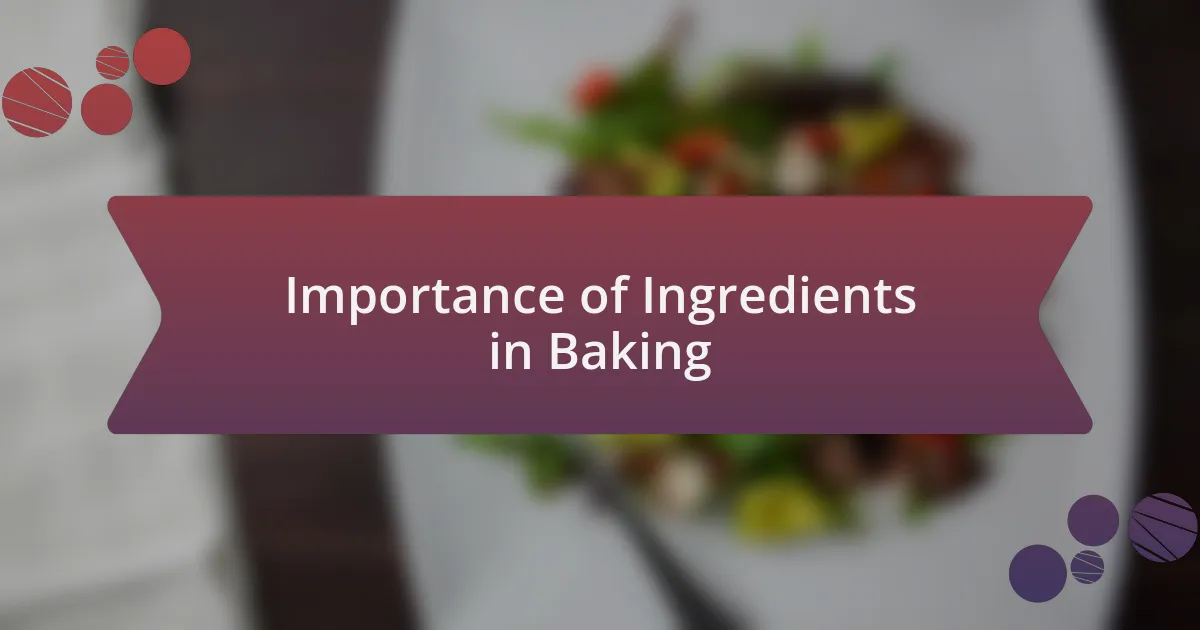
Importance of Ingredients in Baking
The choice of ingredients can truly make or break your baking. For instance, I learned the hard way that not all flours are created equal. When I switched from all-purpose flour to a pastry flour for my pie crusts, the difference was astonishing. There was a noticeable tenderness in the crust that I had been missing, highlighting how crucial it is to choose the right type of flour for your specific baking needs.
Fat is another game changer. I once experimented with coconut oil, thinking it would be a healthier alternative to butter. While it gave my crust a unique flavor, the texture was unfortunately less flaky than I desired. This taught me that the type of fat matters not just for taste but for the overall texture, too. Have you ever had a crust that then fell flat because of your choice in fat? It’s moments like these that really emphasize why ingredient selection is so vital in baking.
Water, while seemingly mundane, is another ingredient that deserves attention. I remember the first time I measured water too slowly and accidentally added too much. The over-hydrated dough was a nightmare to work with! It was then I realized how important precise measurements are in baking. Each ingredient plays its role in the final outcome, and even slight variations can lead to vastly different results. What has been your experience with ingredient ratios? Do you find yourself adjusting as you go along, or do you stick to the recipe?
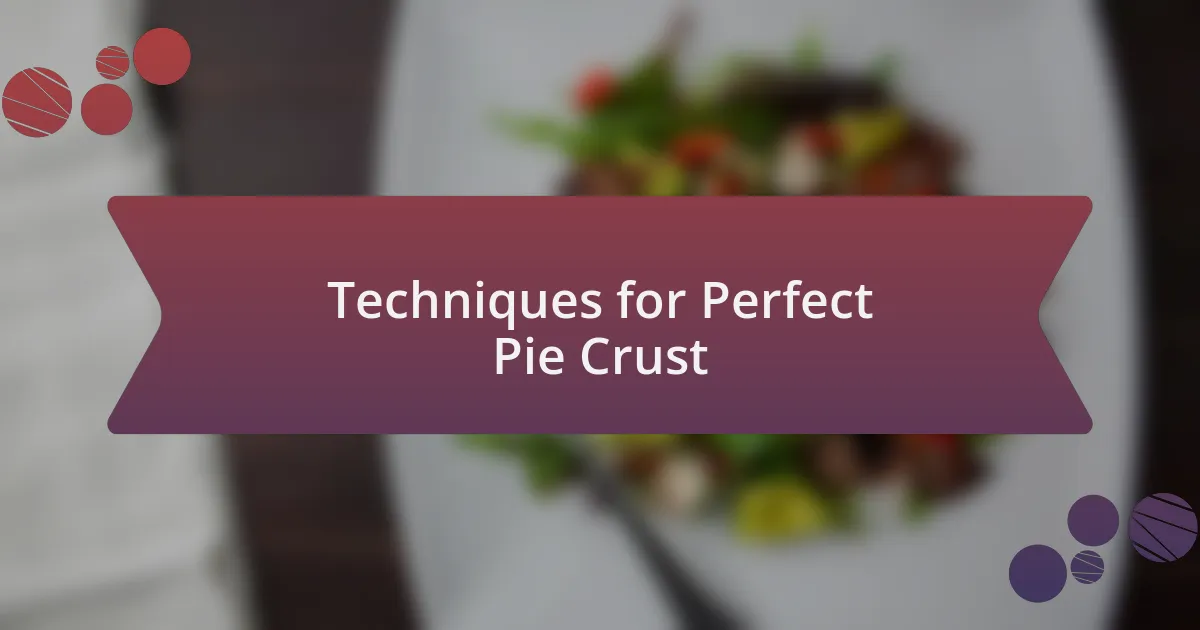
Techniques for Perfect Pie Crust
When it comes to making the perfect pie crust, one technique I swear by is using a method called “cutting in” the fat. I find that working the butter into the flour with a pastry cutter allows the fat to form tiny pockets throughout the dough. This not only ensures flakiness but also creates that delightful crunch. Have you ever felt that satisfying texture in a slice of pie? It’s all in the technique.
Chilling the dough is another crucial step I’ve learned to prioritize; letting it rest in the refrigerator helps to relax the gluten. I can recall a time when I rushed this step out of impatience, and my crust ended up tough and chewy. Trust me, waiting that extra half hour is worth it to ensure a tender bite. How do you usually manage time while baking? It can be tempting to rush, but slowing down is sometimes the key to success.
Finally, I’ve discovered that blind baking can truly elevate a pie crust. Popping the crust in the oven without the filling first helps prevent sogginess, especially for fruit pies. I vividly remember pulling a perfectly golden crust out of the oven one day—it was a moment of triumph. Have you ever tried this technique? If not, I encourage you to give it a go and see how much it transforms your pies!
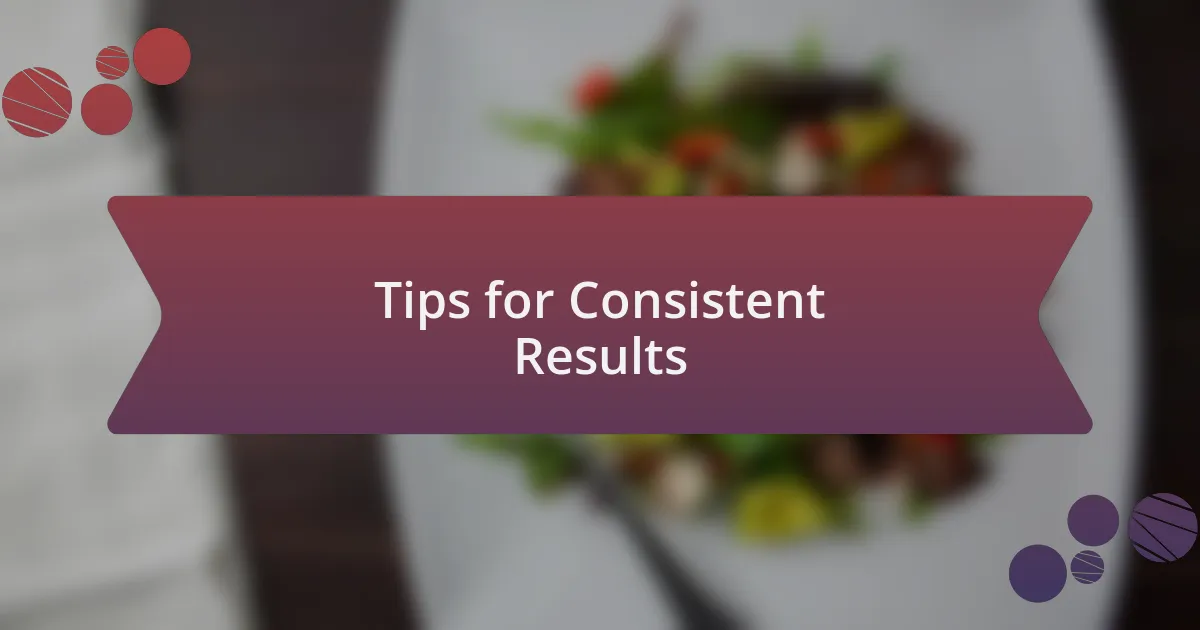
Tips for Consistent Results
To achieve consistent results with pie crusts, temperature control is essential. I always make sure my ingredients are cold, especially the butter, right before I start mixing them. There was a time when I forgot this step, thinking room-temperature butter would be easier to work with. The difference was night and day; my crust turned out dense instead of flaky.
I’ve also found that measuring accurately can’t be overlooked. For example, if I skimped on the flour even slightly, it resulted in a dough that was too sticky to handle. Using a kitchen scale for precision has become a game changer for me. Have you considered giving weighing your ingredients a try? It might just save your crust from disaster!
Lastly, consistent techniques ensure a level of predictability in baking. I’ve learned to stick to my rolling method: always roll from the center outward and to keep the dough moving on a floured surface. I remember a particularly frustrating day when my crust kept sticking, and I nearly threw in the towel. Adjusting my approach turned that experience around completely. What techniques do you follow to keep your crusts reliable? It makes all the difference in the world.
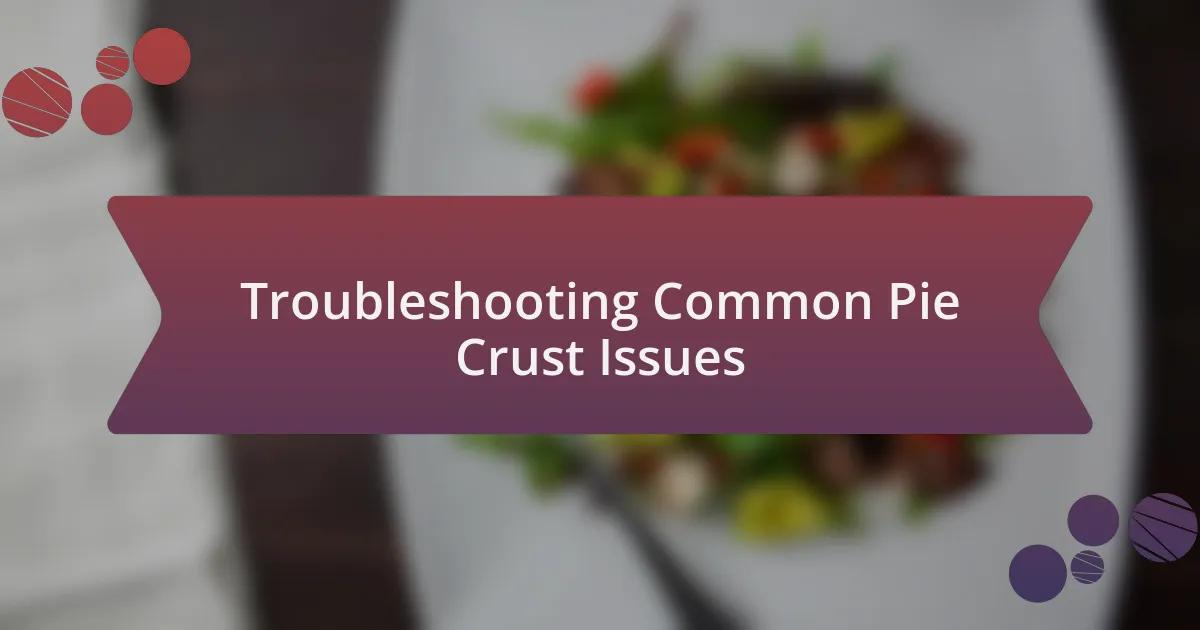
Troubleshooting Common Pie Crust Issues
When my pie crust shrinks during baking, it used to frustrate me endlessly. I discovered that this often happens because the dough is not relaxed enough before rolling it out. I now make it a point to let my crust rest in the fridge for at least 30 minutes, which not only improves the texture but also keeps it from retreating in the oven. Isn’t it amazing how giving it a little time can change the outcome?
A common issue I faced was ending up with a crust that felt tough rather than tender. This is usually a sign of overworking the dough. I remember the first pie I made where I thought kneading would be beneficial. Spoiler alert: it wasn’t! Now, I mix just until combined and then stop. How often do we push ourselves for perfection only to learn that gentleness yields the best results?
If I’ve ever had my crust turn out too dry, I’ve learned to adjust my approach. Initially, I thought adding more flour would help, but this only made the situation worse. Instead, I started adding ice water a teaspoon at a time. The difference in texture and moldability was profound. Do you find it challenging to gauge just the right moisture level in your dough? It’s truly a balancing act that requires a little practice but pays off with a stunning pie crust.